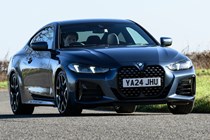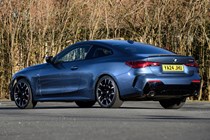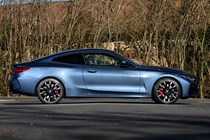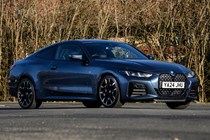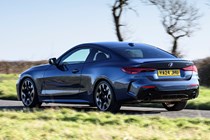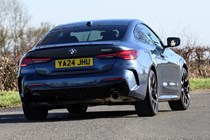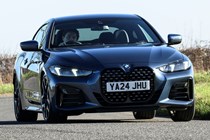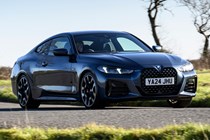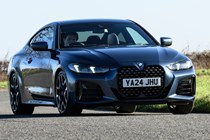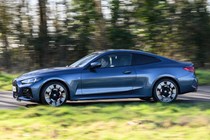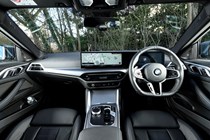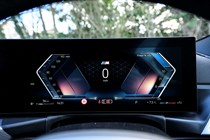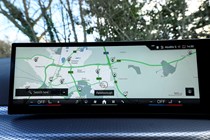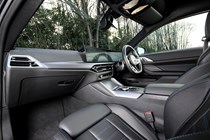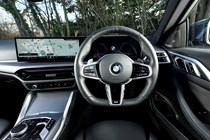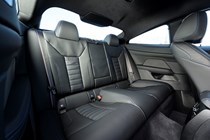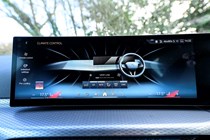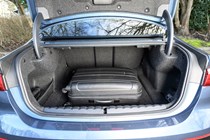
BMW 4-Series long-term test

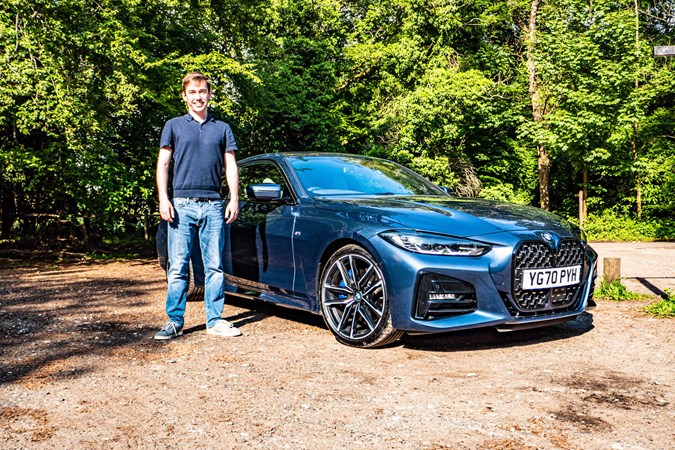
Back at the end of 2020, James Dennison took delivery of a BMW 4 Series long-termer in 420i M Sport spec. Read on to find out his thoughts and experiences on the styling, running costs, engines, technology and much more.
Jump to:
- Update 2: Practicality and space
- Update 3: How much does it cost to run a BMW 4 Series?
- Update 4: Options and equipment – which ones are worth it?
- Update 5: Engine and handling | Petrol or diesel?
- Update 6: Verdict on the 4 Series
Watch the accompanying video series here.
Update 1: Welcome
Introducing the BMW 4 Series Coupe in 420i M Sport spec.
Introducing my latest long-term steed, a striking Arctic Race Blue metallic BMW 4 Series. And, when I say striking, I mean it, because much of the chatter around this car since the first official pics were seen a few months back, has focused on that grille. Large and decidedly unsubtle it’s split opinion right down the middle. Some think it works, others are violently against its very existence – ‘an affront to the BMW badge’ is a phrase I’ve heard a number of times.
However, at the end of the day, an object’s looks are, by definition, highly subjective. What really matters with this car – and indeed any – are what’s under the skin. And I fear that in all the furore over its appearance, this may have been lost somewhat.
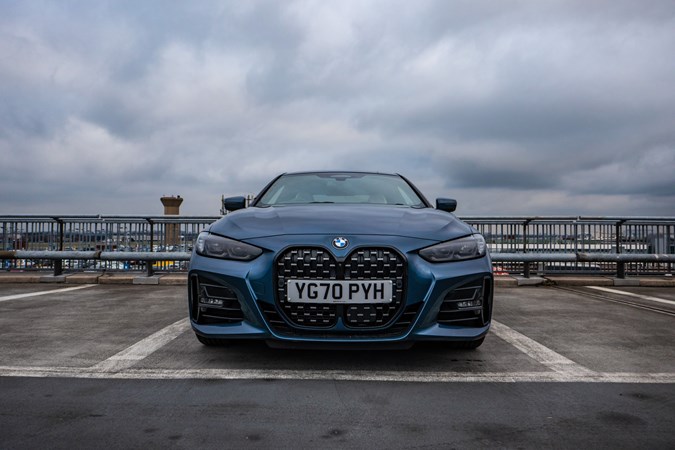
So, in order to try and rectify this I have six months to find out what the G22-generation 4 Series is hiding under that controversial body and figure out whether it’s a better car than chief rivals such as the Audi A5 Coupe, Mercedes-Benz C-Class Coupe and Lexus RC. But, before I get properly stuck in, here’s a rundown of exactly what I’m working with.
The spec – BMW 420i M Sport
The car in question is a 420i M Sport model. It’s expected to be the biggest selling variant of the 4 Series range and it’s not hard to see why. Early impressions suggest that the 184hp 2.0-litre petrol does an excellent job of replacing the previously popular (and now very much out-of-vogue) 2.0-litre diesel. Smooth and torquey enough (300Nm from 1,350rpm), it returned a highly respectable 49.2mpg on the 100-mile drive home from picking the car up – far greater than the claimed 42.2-44.1mpg figure.
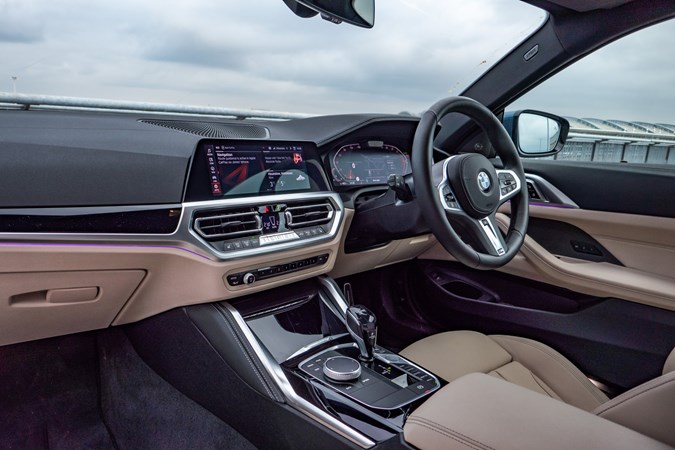
It’s also worth noting that this car is absolutely loaded with kit and has a hefty £48,925 list price (more on that later). So, as well as the reasonable M Sport standard equipment, it’s got the Adaptive M suspension with sport and comfort modes. How this will impact the overall drive of the car (especially on the pretty but large 19-inch alloy wheels) is what I’m bristling to find out. Rear-wheel drive is standard on this model, as is an eight-speed automatic transmission – no more manuals on this generation of 4 Series (at least in the UK).
Huge equipment list
Trawling through the brochure, it’s initially hard to find an option that this 420i doesn’t have. As far as I can tell, the only tech missing is the Visibility Package, featuring BMW Laserlights and high-beam assistant. Now, interestingly, the latter is technically on the vehicle (it’s standard on M Sport cars) yet BMW doesn’t activate it from standard. Instead, you need to purchase it, either as part of the Visibility Package or using the MMI. Opportunist on a car with a £40k starting price?
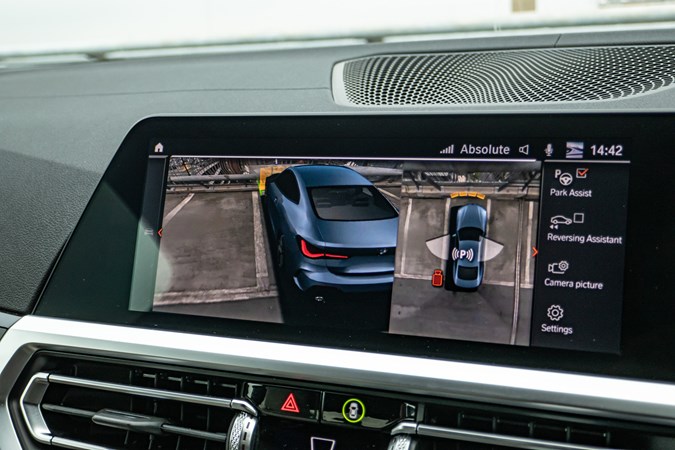
Equipment that is fitted and activated, however, includes the M Sport package Pro, Technology Plus Pack, Comfort Plus Pack and individual piano black interior trim. All features that we’ll be sure to explore in future updates and, crucially, let you know if they’re worth paying the extra money for.
*Apologies for the dirty car – finding a car wash that’s open isn’t easy at the present time!
Starting mileage: 731 miles
Claimed fuel economy: 40.6-44.4mpg
Update 2 – Practicality and space
Since there’s not a huge amount going on at the moment, it seemed an appropriate time to discuss my first impressions of the 4 Series’ space and layout. Sure, it’s a svelte coupe, but can it cope with the practicality demands of everyday life?
Granted, you’re unlikely to be buying a sleek, three-door coupe for its practicality and boot space. But that doesn’t stop it from being a consideration – especially if said car is going to be your only form of personal transport. Every so often there’s a need to take something large and bulky (or someone large and bulky) from A to B. Hence why I’m putting my sensible hat on this week and talking 4 Series space.
Front seat space in the 4 Series
No problems up front – as you might expect. I’m not the world’s tallest human being, but my average-height frame fits like a dream and there’s a good few inches of spare headroom. Storage space is also generous, with a large glovebox and capacious under-armrest area capable of taking bulky items. The door pockets, too, have a neat set of dividers in them which is perfect for keeping your water bottle and sunglasses case apart.
A couple of things I have noticed about the driving position in recent days is that it’s not quite as excellent as I first thought it was. Admittedly, I’m only spotting this now as I’ve recently spent time in a Porsche 911 and Porsche Taycan – both home to exemplary driving positions – but it pays to aim high, right?
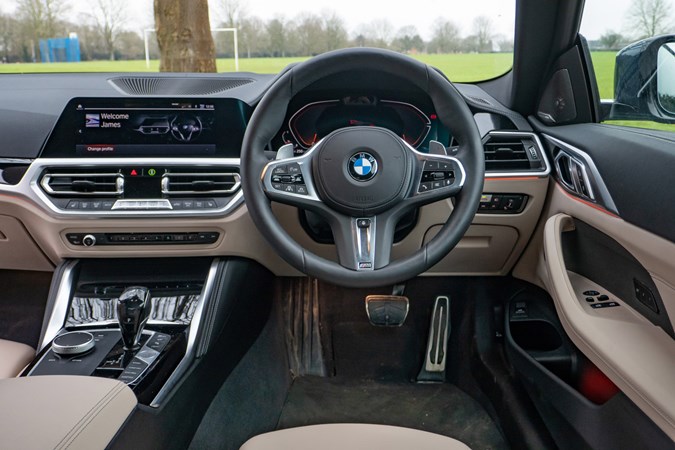
Either way, even in its lowest setting the seat still feels a touch too high (especially when you have the backrest quite upright like I do) and the pedals are noticeably offset. What I mean by that, is that instead of the two pedals lining up with the center of the steering column, the accelerator is shoved out to the right a couple of inches.
Of course, this is not the end of the world, but I do wonder what effect it has on my posture and general seating position over long journeys. Still, there is plenty of adjustment on offer (in the wheel and the seat), so I’ll report back on how this all comes together in a later update.
BMW 4 Series rear seat space
As you’d expect in a three-door coupe, it’s a bit of a squeeze climbing in through the gap into the rear seats. And while the electric sliding front seat means you need very little effort to move it out the way, it does take longer than if it was fully manual. Impatient passengers beware.
Once back there however, there’s a decent amount of leg space behind my own driving position. My knees have plenty of room, even if the gap under the front seat is a little tight to slide my feet into. However, like most coupes, it’s the headroom that’s the big question mark.
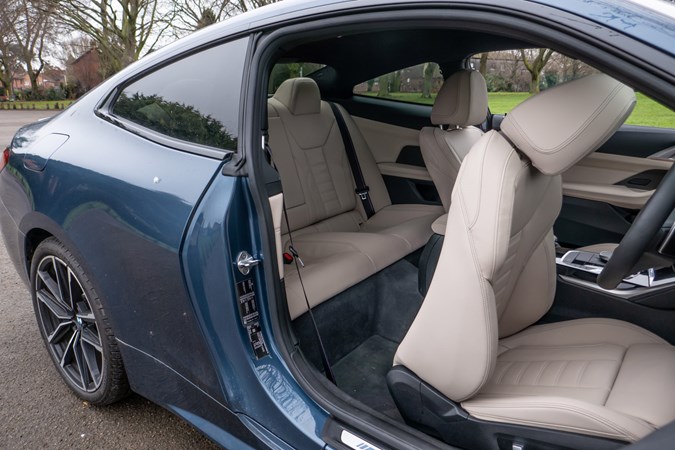
At 5’10” tall (short legs, long torso), I can sit relatively comfortably in the back of the 4 Series, but only if I slouch down and slide my bum forwards on the seat. If I try and sit bolt upright, my head is uncomfortably pushed forwards by the roof. Not ideal, but also not uncommon.
As a (now admittedly commonplace) bonus, you do get the benefit of a climate control switch in the back, while the nets on the front seats are a small but welcome touch. Mind you, the comparatively tiny door pockets are less so.
BMW 4 Series bootspace
Let’s just say my experience of the 4 Series bootspace didn’t get off to the greatest of starts when I couldn’t squeeze a large parcel in no matter how hard I tried. See, at 440 litres it’s very similar to the Audi A5 Coupe (and far more than the Mercedes-Benz C-Class Coupe), yet the opening to the boot is restrictive.
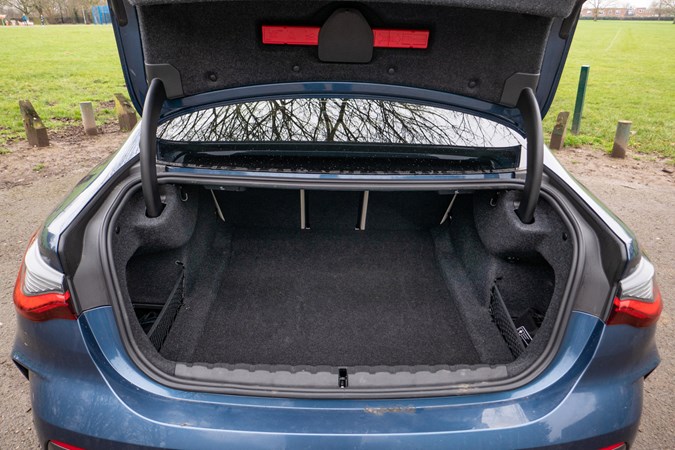
Of course, this isn’t something unique to the BMW – all coupes have a similar issue. But just bear in mind that while the on-paper boot volume should easily be able to swallow a copious amount of luggage, the shape of said cargo is crucial to your chances of packaging success.
As ever, deep side pockets with netting are invaluable and mean you can stop the smaller objects from flying around the boot when you’re in the mood for some ‘enthusiastic’ driving. More on that in a later update…
Current mileage: 1,252
Average fuel economy: 36.4mpg
Update 3 – How much does it actually cost to own a BMW 4 Series?
It’s easy to find out what the cash price is for a BMW 4 Series. This one in particular is £48,925 with options. But how much does it actually cost to run and own?
One of the many quirks about buying, running and driving a car in 2021, is that the OTR (on-the-road) cash price bears little resemblance to what you’ll actually pay month-to-month. Indeed, the soaring popularity of car finance (Personal Contract Purchase, Personal Contract Hire etc) means that the monthly repayment figure is now far more relevant than the sticker price you’ll often see quoted in car reviews.
Take my BMW 4 Series long-termer for example. Without options, the cash price is £40,465, yet only a small percentage of buyers will hand this figure over in full, upfront, whether out of their own pocket or via a personal loan. So what I want to find out in this update, is how much would actually come out of my bank account every month if I were to ‘buy’ and run a BMW 420i M Sport using BMW’s PCP finance scheme. And, to give some context, I’m also going to collect similar figures for an Audi A5 Coupe S Line 40 TFSI.
Using BMW Select (PCP)
It’s been a while since I’ve had a play around with a manufacturer’s finance calculator, but thankfully BMW has a reasonably easy-to-access program that allows me to collect a basic set of figures. I’m putting down a £4000 deposit (plus BMW’s £1,973 deposit contribution) and looking for a 36-month term with an annual mileage of 10,000. APR is 2.9%.
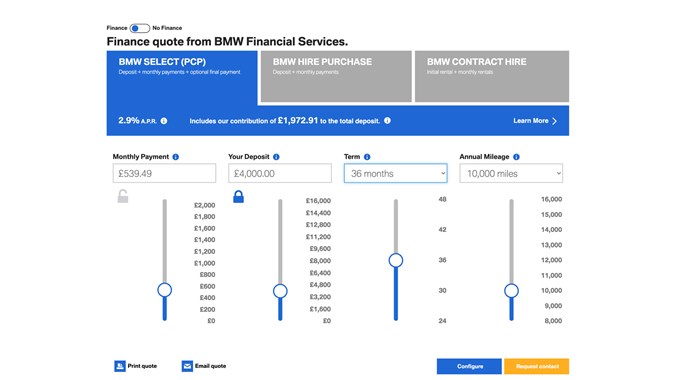
This all works out to 35 monthly payments of £539, with an optional final payment of £17,865. Overall, this adds up to a total amount payable sum of £42,721 (£2,256 more than I would have paid in cash, despite the deposit contribution).
Fuel, insurance, servicing and tax
We’d rather we didn’t have to pay for any of the above, but unfortunately they’re all essential – and it does add up! For the purposes of insurance, I used my 40-year-old alter ego, Ken Dennis. He lives in Peterborough, has had his licence for over 20 years and has a 10-year no-claims bonus. He keeps his pride and joy parked on the street and uses it for social, domestic and pleasure + commuting. The result is a £540 insurance bill paid annually.
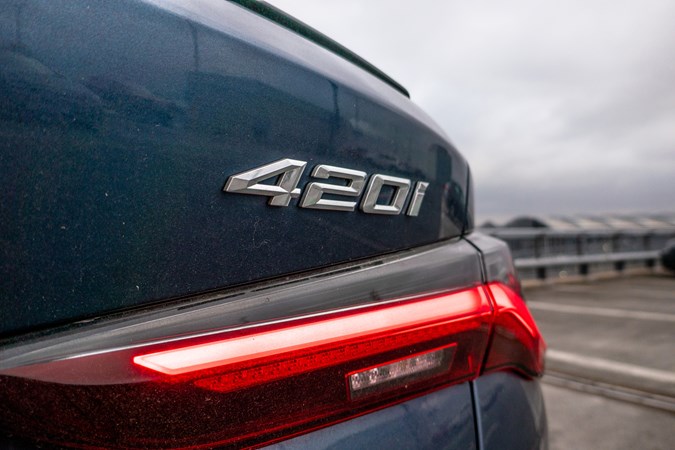
As for fuel, I took the 39mpg approximate average I’m getting from the 420i and calculated how much it would cost to fuel it for 10,000 miles using the average UK fuel price. This came to £1,462. Servicing meanwhile is based on BMW’s 36-month payment plan (£25 a month), while tax is hefty after year one (which is included in the price) as the vehicle costs over £40,000 and thus attracts a surcharge. Total = £490 per year.
Including the £4,000 deposit, I make that a first-year cost of £12,822 for the BMW. Year two and year three, meanwhile, are £9,312 per annum, working out at roughly £776 per month (for the latter two years).
Is it cheaper than an Audi A5?
In cash price terms? No. The A5 Coupe S Line 40 TFSI comes in at £42,965, although that is including £675 extra for metallic paint – an option that the calculator does not appear to let me remove. However, Audi does offer a far more generous deposit contribution of £5,000, plus (at the time of writing), are currently doing a ‘three months on us’ deal, where the interest rate is reduced to 3.1% APR.
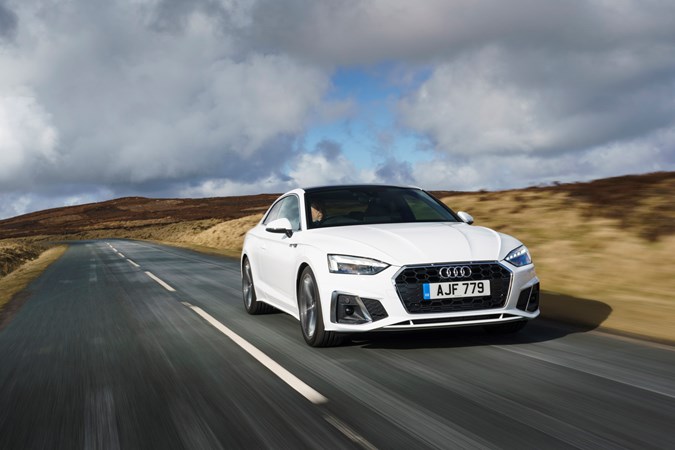
However, the A5 Coupe still comes in at £635 per month – £96 more than the BMW, totalling up to in excess of £1,000 extra per year. Optional final payment, though, is cheaper at £16,052. We can also assume that fuel will be roughly the same, while tax will be identical. Add this onto a £540 a year insurance bill (£52 less than the BMW) and servicing working out at £264 (first year) and the A5 Coupe will cost around £13,886 for the first year of ownership. This then drops to £10,376 and £10,112 over years 2 and 3 respectively – coming to roughly £865 and £843 per month.
So, a notable jump in monthly costs over the BMW and one that’s also reflected in how much you’ll pay for the cars should you hand them back at the end of the three-year term. The 420i will set you back £31,446, while the A5 Coupe is considerably more at £34,374. However, should you choose to complete the purchase and pay the balloon payment, the Audi will cost £16,052, while the BMW is almost £2k more at £17,865. This means final scores on the doors are £49,311 for the full PCP deal and running costs of the 4 Series and £50,426 for the A5 Coupe.
The message, then, is both are worth considering if you plan to make the purchase at the end of three years. However, if you intend to hand the car back then think long and hard about whether the Audi is worth the near £3k premium… Anyhow, enough man maths. Next time I’ll be going through every last piece of optional equipment on the 420i, telling you whether I think it’s worth paying extra for or not. Stay tuned.
Until then, don’t forget to tweet me @JDennisonCars (or email james.dennison@parkers.co.uk) with any questions you have about the new 4 Series and what it’s like to live with.
Current mileage: 1,856
Average fuel economy: 37.4mpg
Update 4 – Which options should you add to your 4 Series?
James gives you his verdict on the must-have (and must not-have) options packs available on the BMW 4 Series.
So, you’ve got your heart set on a BMW 4 Series. You’ve picked the engine, trim level, exterior colour and upholstery. You’re so nearly at the point where it’s time to part get the chequebook out, yet there’s one thing left. Options.
Almost every new car on sale today can be specced with various bits of equipment designed to impress your mates and make the car easier to live with. And while some are fitted as standard with certain trim levels, many aren’t.
For example, my 4 Series long-termer has a decent spread of standard kit in M Sport spec, including climate control, sat-nav and cruise control, yet there’s plenty more goodies on offer if you’re willing to stump up the cash. Here, I’m going to explain what they are and whether they’re worth your cash.
Comfort Pack
Comfort Pack (£990) includes additional storage compartments and extra USB ports, Comfort Access (keyless entry), an electric bootlid and a heated steering wheel. Note that the Comfort Plus Pack (1,950) adds front lumbar support and electric front seats + memory function for the driver.
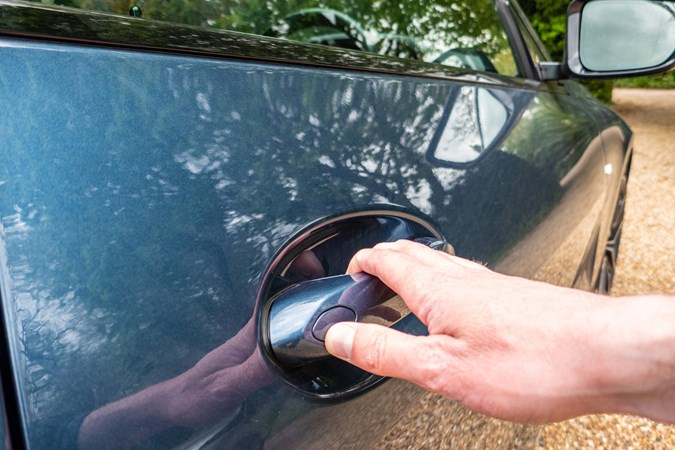
For me, there’s some nice to haves in the pack (such as the keyless entry and heated steering), yet it’s the lumbar support and electric seats that stand out as essential. If you’re not comfortable in a £50k luxury coupe, then what’s the point of it?
Technology Pack
Technology Pack ((£1,900) includes wireless charging, Harman/Kardon Surround Sound, a head-up display and gesture control – among other features. However, upgrading to the Technology Plus Pack (£3,650) adds goodies such as Parking Assistant Plus, Driving Assistant Professional and the Drive Recorder.
Frustratingly, it’s the options on the regular pack that I believe you can do without. The wireless charging is nice but not essential, while the same goes for the sound system and head-up display. Meanwhile, the gesture control is merely a gimmick.
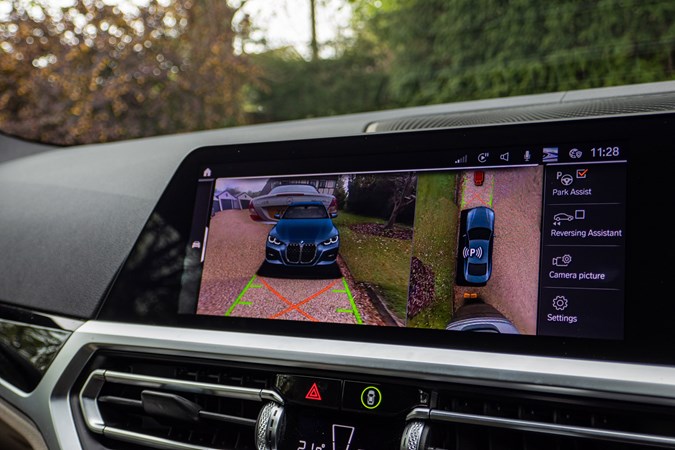
The real value is in the Drive Recorder (which acts as a highly convenient dashcam using the vehicle’s onboard cameras), the adaptive cruise and lane-keeping and the parking cameras – especially when driving in tight urban areas. If you can stretch to the Technology Plus Pack, you won’t be disappointed.
Visibility Pack
I don’t have this fitted to my car yet haven’t ever felt I needed it. Consisting of high-beam assist and Laserlights, the former can be added on its own (the car already has the required tech) and while the latter is impressive, there’s nothing wrong with the standard LEDs in my book. An easy way to save £1,500.
M Sport Pro Pack
Plenty of niceties in this £2,500 pack (M Sport Brakes, tinted glass, Shadow Line detailing) – yet there’s only one you really want. The ride and refinement on my 420i are pretty exceptional and almost all of this is down to the M Adaptive Suspension. Having heard from those that have tried the 4 Series without adaptive dampers, the ride is far less polished.
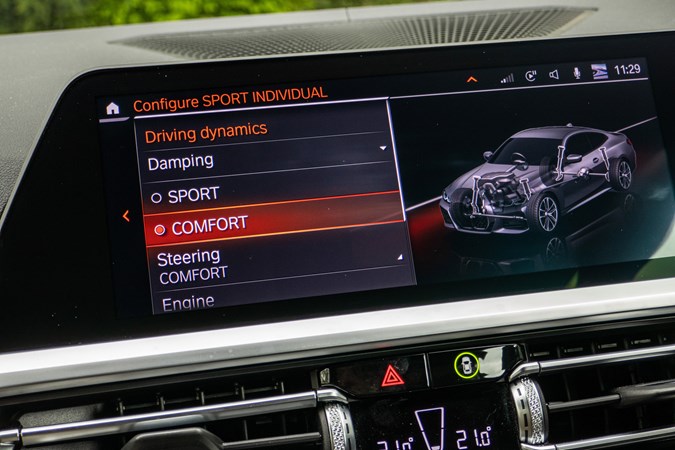
That’s all of the equipment packs on the 4 Series and, predictably, I think three out of the four are worth going for. Do you agree? How would you spec your 4? Let me know by getting in contact using @JDennisonCars or email james.dennison@parkers.co.uk. Tune in next time around when I take a drive in the 420i’s biggest rival – the 420d!
Current mileage: 2,928
Average fuel economy: 39.7mpg
Update 5 – Engine and handling | Petrol or diesel?
James heads off to BMW HQ to drive the diesel equivalent of his long-termer. Will he prefer it to the 420i?
It’s nearly time to say goodbye to the 420i, but before I do, I wanted to see how it stacks up against its biggest rival. The 420d. Yep, what car could be more closely matched to PYH than its diesel sibling, that, until this generation of 4 Series, was the biggest seller in the UK. To find out how my 420i compares, I headed down to BMW to take a spin in a 420d xDrive and come up with a verdict.
420i driving impressions
Driving the 420i is a largely relaxing experience because there’s never enough urgency from the engine to warrant anything remotely sporty. Of course, that sounds like a negative and it probably goes against what you’d expect from a BMW, but it’s not all bad.
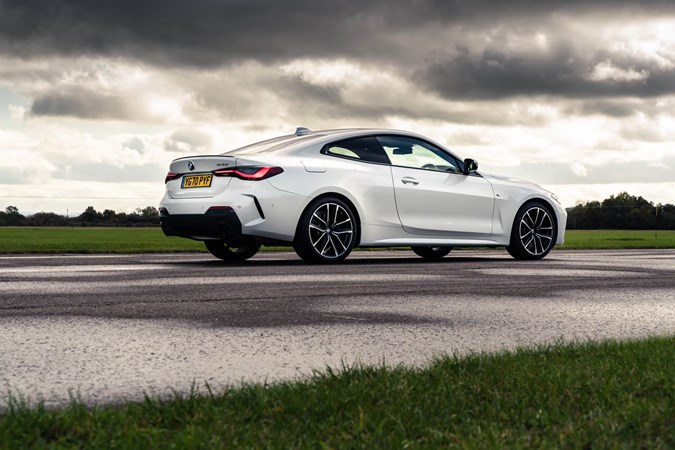
See, the 420i’s 184hp 2.0-litre pulls a clever trick where, when driven calmly, it feels like it has more power in reserve than it actually does. This means you can trickle around, enjoying the excellent ride (from the adaptive dampers) and refinement, feeling as though you’re driving a car with a good 50hp more.
Trouble is, once you do put your foot down, you realise that a) it’s not as powerful as it initially feels and b) the engine becomes thrashy in the higher third of the rev range. Probably not what you want, but the good thing is that this can be solved by simply slowing things down again. And thus, you end up driving the 420i in a slow and relaxed manner everywhere you go.
It has to be said, however, that in doing so you’ll miss out on the 4’s impressive handling capabilities. The steering is quick and direct, the brakes deliver a nice feel and the overall agility imparted from the CLAR platform is notably better than what rivals from Mercedes-Benz and Audi can offer.
420d xDrive driving impressions
On paper, the difference between the 420i and the 420d is considerable. For example, going for the latter gets you an extra 100Nm of torque, and while power is very similar, claimed fuel economy from the diesel is 60.1mpg vs 44.1mpg. However, it’s also worth noting that the 420d is 80kg heavier than the 420i, rising to 145kg if you opt for xDrive.
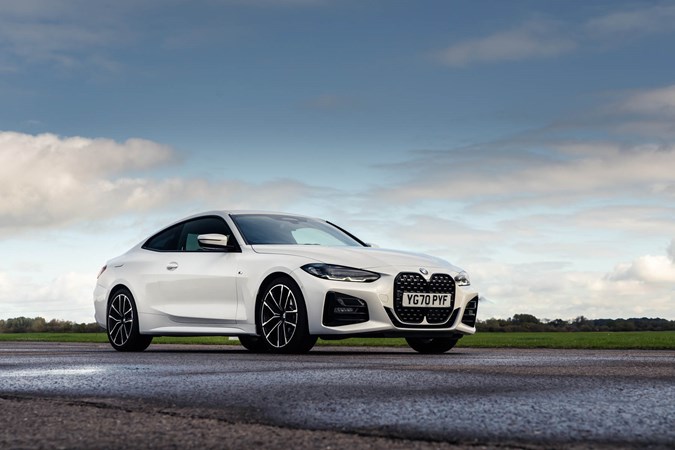
Initial thoughts? Well as you’d expect, the 420i has it for low speed refinement, despite the 420d’s 48v mild-hybrid system that allows electrically assisted coasting and fuel saving. However, once you get onto faster roads and give the throttle a firm prod, the diesel is the quieter of the two and feels far less uncomfortable at full throttle. And while I’ve no doubt that 50+mpg is achievable in the 420d, the trip computer showed less than 40 on our 1.5-hour drive on mixed roads.
What’s more, the handling of the diesel car did not feel as sharp or agile as the petrol, likely owing to the extra weight (of the engine) sitting over the nose. Finally, and despite the increased torque of the diesel, the xDrive all-wheel drive system felt of limited value during everyday driving.
Granted, the roads were dry, yet given both the 420i and 420d produce less than 200hp, the xDrive feels unnecessary – not to mention the impact it has on kerb weight and fuel economy. A set of all-season or winter tyres on a rear-wheel drive car could be a worthwhile alternative.
Final thoughts
420i or 420d? Having now driven both engines, I’d find it hard to give up the 420i in favour of a 420d. Yes, the refinement under load isn’t as good as it should be in the petrol, and the diesel does benefit from a good chunk of extra torque, but considering how much I drive in cities and country roads, the 420i still feels like the one to get. It’s cheaper, smoother (if you drive to its strengths) and feels lighter on its toes coming through corners. In short, it’s not hard to see why it’s the best seller.
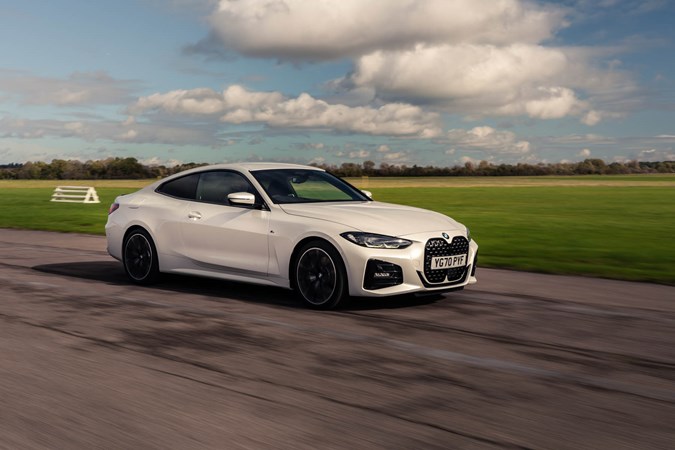
Current mileage: 4,115
Average fuel economy: 41.3mpg
Report 6 – Farewell
Alas, it’s that time again where I must say goodbye to a car I’ve called my own for the last six months. OK, maybe that was wishful thinking (it always belonged to BMW UK), but the fact I’m genuinely quite sad to part ways with the 4 Series says a lot about my time with it.
Back when it was delivered at the end of last year, I remember feeling a tiny bit defensive over the 4. I kept being reminded that the looks weren’t to everyone’s tastes (the grille was the main issue), yet to my eyes it was – and still is – a striking design that stands out in ways its rivals simply do not.
That said, the Shadow Line exterior option (available only as part of M Sport Pro package) is, in my eyes, essential as it removes the chintzy elements chrome from the grille and lifts the whole front end of the car. Subjective styling points aside, however, allow me to remind you what made the 420i M Sport such a capable companion.
So much tech in the 4 Series
Admittedly, much of the 4 Series technology offerings were optional extras and if you want to know which ones were worth it, click here to read the full report. However, as a summary there’s still an impressive array of standard equipment, including sat-nav, three-zone climate control, cruise control and a 12.3-inch digital instrument cluster.
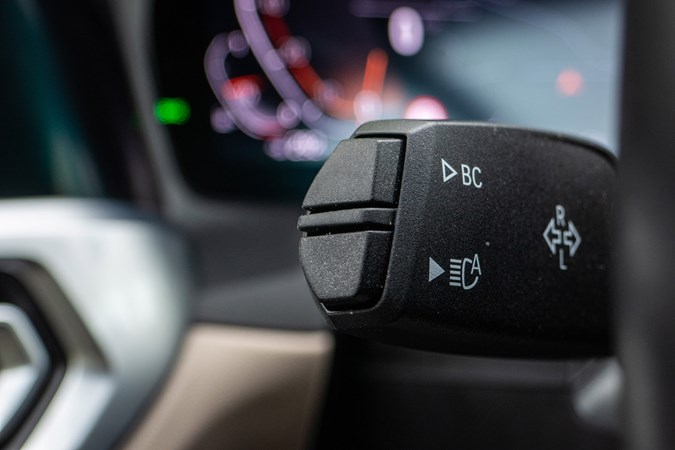
It’s almost all usable kit as well, with every piece of tech getting a workout during my time with the car. A particular highlight was the Drive Recorder (available as part of the Technology Plus Pack), thanks to its ability to act as a built-in dash cam. Offering four different angles of recording, it gave the convenience and security of having a camera in the car, yet none of the untidiness you’d associate with third-party units.
Parking Assistant Plus (capable of parking the car automatically) and Driving Assistant Professional (adding adaptive cruise control and lane-keeping) were also welcome, as was the M Adaptive Suspension (more on that in a bit). Less useful, however, was the gesture control (quickly became annoying after going off every time I moved my hand) and the fact that keyless entry is not a standard feature (optional as part of the Comfort Pack).
Frugal and (mostly) quiet 2.0-litre petrol
Go back to the previous generation 4 Series and – especially when it first came out in 2013 – you’d likely have seen a lot of 420d M Sport models on UK roads. That’s because the 2.0-litre diesel was the biggest selling engine, boasting excellent all-round performance and impressive fuel economy.
However, for this latest 4 Series the 2.0-litre petrol (420i) is the expected best seller – hence why I was keen to experience it on my long-termer. I wanted to know how it performed on a day-to-day basis and whether it worked better than the 2.0-litre diesel alternative. My final answer, after thousands of miles at the wheel and a test drive in the latest 420d? I’m not completely sold, but the 420i does enough to justify its popularity.
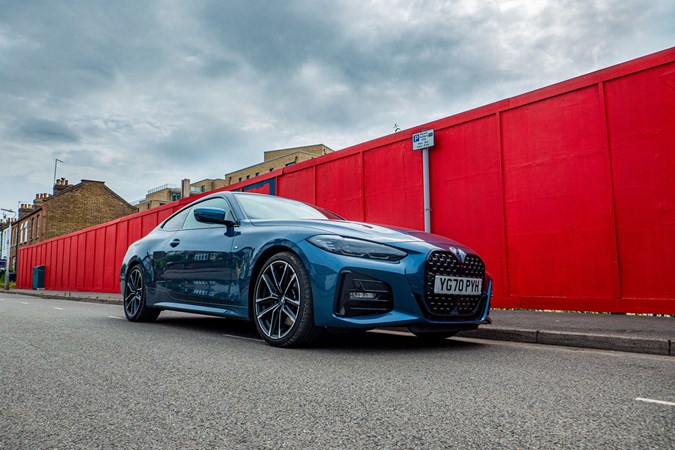
General refinement and fuel economy are both exceptional – I ended up getting over 43mpg on average and 50+ on longer runs – but there is avenue for improvement. Working the engine hard leads to a strained soundtrack that reflects how a 1.6-tonne luxury coupe could do with a little extra torque. Yes, it manages 0-62mph in a respectable 7.5 seconds, but I’d rather a more effortless feel to the acceleration – something the 420d still manages. My recommendation? Do what you can to stretch to the punchier 430i model.
Cheaper on PCP finance than an Audi A5 Coupe
Cash prices only tell you half the story when it comes to car buying, so I was keen to see how the 4 Series faired on PCP finance compared with one of its biggest rivals – the Audi A5 Coupe. All in, including fuel, insurance, servicing, tax etc, the A5 Coupe and 4 Series were close should you want to buy the car outright at the end of the contract – £50,426 for the former and £49,311 for the latter (prices correct at the time the original piece was written).
However, while £1,100 on a £50k over three years isn’t a dealbreaker, the difference should you hand the cars back after three years was far more noticeable. The BMW came in at £31,446, while the Audi was £34,374 – almost £3k more. Therefore, if value-for-money is a primary consideration (and when is it not!), the 4 Series comes out the better bet.
Would we recommend the BMW 4 Series?
It’s an unequivocal 100% yes from me. The sheer breadth of the car’s all-round abilities is deeply impressive, as is – in my eyes at least – the way in which it stands out from the crowd with its striking styling. Granted, the 420i version won’t be for everyone, so it’s worth checking out the 420d and 430i (ideal if you can stretch to it). Also try and leave a little spending money aside to pump up the options list – the M Sport Pro and Comfort Plus Packs both featuring key pieces of equipment.
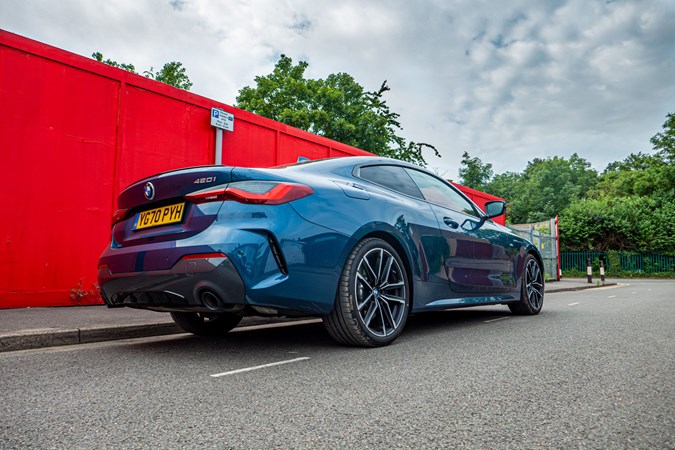
If you enjoyed this long-term review then please don’t forget to check out the partnering video series on the Parkers YouTube channel, plus drop me a line at @JDennisonCars or james.dennison@parkers.co.uk if you’ve got any questions about the 4 Series.
Final mileage: 5,521
Final average fuel economy: 43.3mpg


